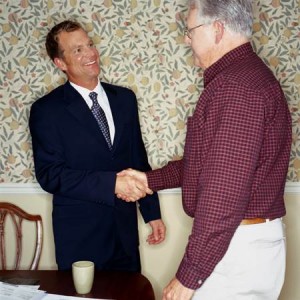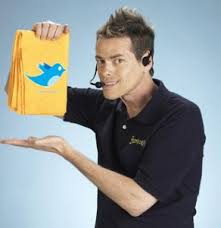 Selling your products and services means first selling yourself, building trust. While most junior-league sales people think this has to do with generating rapport, building trust has nothing to do with that (please read SPIN Selling, in my opinion, the best book on sales).
Selling your products and services means first selling yourself, building trust. While most junior-league sales people think this has to do with generating rapport, building trust has nothing to do with that (please read SPIN Selling, in my opinion, the best book on sales).
Here’s what we have learned at our company. In selling yourself and your financial products and services, know that we live in a culture where people form an instant impression of you. And that instant impression is the difference between sales success and sales failure. Investors and insurance buyers love to form opinions with almost none of the facts. Just listen to any economic prognosticator on television or your clients’ opinions about the economy to see what I mean regarding people dismissing the facts.
This instant prejudgment forces you to make your best first impression in the first seconds of contact, whether it be in person, in writing or on the phone. Let me give you some specific examples:
When sending direct mail, do all of your envelopes get opened? I doubt it because you allow the recipient to prejudge the contents without opening the envelope. You have a return name on the envelope and you may also have a printed message on the outside of the envelope. So if your company name is ABC Insurance, the prospect immediately knows that inside is an insurance pitch and they don’t open the envelope. You have a meter stamp and maybe a bar code or carrier route sort indicator. All of these scream “JUNK MAIL.” You will never get to communicate your message because the envelope gets tossed in the trash, unopened. You have allowed people to prejudge you because you have made a poor first impression.
Marketing Tip: mail items to strangers in a plain business envelope with a first class stamp, no messages, no bar codes, no return name and with the recipient’s address laser printed on the envelope or through a window envelope. It’s impossible to prejudge the contents of a blank envelope and the recipient must open it.
The item in the envelope must have a super-compelling headline and it must be the first thing the recipient sees when they pull the information from the envelope. The first thing that the prospect sees must answer their most important question, “what’s in it for me.” If the first item the recipient sees does not grab their interest in seconds, you’re toast.
Marketing TIP: include a big compelling headline and fold the page so that the headline is the first item seen when opening the envelope flap. Make sure that headline answers their most important question.
When sending information requested by a prospect or to a referral, include your picture and biography. (I have my picture at the bottom of every letter I send to the right of my signature). Remember that you are a stranger to the prospect and people are conditioned to scared, or at least wary, of strangers. By including your picture and biography, they get to know you. When you call, your prospect feels like they know you because they know how you look.
Marketing Tip: find the best commercial photographer in town as a good picture can open the door to win new clients.
Brian Tracy, well known motivational educator says, “the reason image is so important is because people are primarily visual and they form their first impression of you by the way you look on the outside. If they do not like what they see on the outside, they very seldom take the time to probe any deeper. In any field of sales and marketing where the impression you make on others is important to your success, it is absolutely essential that you look the part that is consistent with the financial product or service you wish to sell.”
What the previous paragraph means is that your dress, your hairstyle and other items of appearance are not for your liking. If you want to make a lot of money, these elements better be for your prospects’ liking. Your best sales tactic is a great first impression. Since Americans prefer someone who is clean-cut you better shave the facial hair, get rid of the ponytail and buy a quality suit.
As to your biography, DO NOT write a “me” biography. A “me” biography is where you talk about yourself “I graduated from ABC College…”, “I am a Certified Fund Specialist,” etc.
Marketing Tip: Write it in the third person and before mentioning your position or credentials, have three to four sentences about what you can do for them:
“John Doe has assisted over 800 Pennsylvania investors grow their retirement income up to 50% and reduce taxes up to 80%. In some cases, investors have used John’s advice to eliminate taxes on social security income and eliminate estate taxes. You may have seen his informative articles on ways to reduce stock market risks in the Philadelphia Inquirer.”
Only after you have established why you are valuable, do you mention where you went to school and your credentials. Potential clients are interested in “what can you do for me?” before they want to hear anything about you. And when you do talk about yourself, keep all sales language out of the biography. That means you do not say “John is a registered rep with ABC securities” (unless your broker dealer requires it). Not only do 90% of investors not know what a registered rep is, the other 10% of the people know that you just want to sell something. Sure, everyone knows you’re in business to make a living, but never push any sales language in their face in a biography.
And obey some common courtesies so that people do not prejudge you negatively:
1. On your first telephone contact, do not interrupt prospects. It’s a problem that some of my hard-driving East Coast friends have.
2. Do not close to an appointment without identifying their motivation so that you can offer a potential benefit. When you try to close for a meeting and the prospect’s desires have not been isolated, you will appear pushy.
3. When mailing, do not take a 4-panel letter-sized brochure and stuff it into a business envelope. Use a 9 x 12 envelope so that the brochure can lay flat and the mailing looks professional.
Focus on those first seconds of communicating with the prospect to gain your opportunity to present who you are and what you can do. If you fail in the first seconds, you may not get a chance to go forward.



